Throughout the ages, noblemen, military officials, and wealthy merchants needed a way to keep their valuables safe. Locks and strongboxes were essential to the preservation of wealth, transporting valuables such as gold, silver, and jewels, as well as protecting important documents such as bills of laden or sensitive communiques.
Wooden chests with iron banding and locks could easily be broken into or carted off, so a stronger, heavier, and more secure alternative was needed.
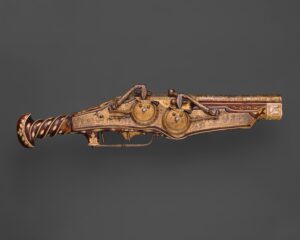 For centuries, the blacksmiths and artisans from Southern Germany were known to be masters at making the finest suits of armor, weapons, locks, tools, and other works of iron and steel.
For centuries, the blacksmiths and artisans from Southern Germany were known to be masters at making the finest suits of armor, weapons, locks, tools, and other works of iron and steel.
 They were also masters at manufacturing early firearms such as this Double-Barreled Wheellock Pistol made for Emperor Charles V (1519–1556).
They were also masters at manufacturing early firearms such as this Double-Barreled Wheellock Pistol made for Emperor Charles V (1519–1556).
This suit of armor was crafted by Kunz Lochner (German, Nuremberg, 1510–1567).
Sometime in the early 16th century, the locksmiths and blacksmiths began to design and build a state-of-the-art chest with an intricate locking mechanism made entirely out of iron and steel.
What they created ended up being so advanced and secure that it would be used all over the world for the next 300 years. Even George Washington used an Armada chest to store his valuables. 1
These prized strongboxes are commonly known In German as “Eisentruhe oder” or “Kriegskasse” (Iron Chest or War Chest) but are more commonly referred to as Armada Chests as many were used to carry gold and treasure on sailing ships. They are also known as Nuremberg chests, Corsair safes and of course treasure chests.
The majority were made in Nuremberg and Augsburg Germany, and many were hand decorated in Holland. Some similar chests were also made in Austria, Switzerland, France, and Spain.
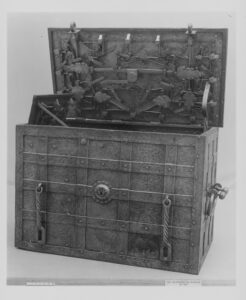
Armada chests were made in a variety of sizes from small 4-inch gift boxes, to foot long jewelry caskets, to large 6’ bank reserve or payroll chests. The most common size Armada chests seem to be the mid-size versions that could be moved by two men when empty. These measure roughly 24” – 36” in length, 14’-16” in width and 14”-16” high.
Empty, these chests can weigh around 150 lbs. Fully loaded with gold, these chests could weigh close to half a ton.
For perspective, if a mid-size chest could hold a pirate’s plunder of 15,000 1 oz. gold coins, the gold weight alone would weigh over 900 lbs. Some of the larger chests used in castles, treasuries, or banks weighed well over 500 lbs. empty.
Some Armada chests came with holes drilled at the bottom so they could be bolted down to the floor beams of a castle or in the Captain’s quarters of ships to prevent them from tipping over in rough seas or being carted off by pirates. These chests would have been used to hold sailors wages, the captains personal valuables, as well as to protect paper documents such as maritime charts, bills of lading, or manifests from rats. It has been documented that Spanish colonial mints in the 17th century located in Potosi and Mexico City used these chests not only to store gold or silver, but also to store the dies used to mint the coins. It has been noted that the dies used to mint Spanish colonial coinage were locked in these chests specifically so the mint assayer wouldn’t have the only key or access to the dies. Three mint officials had to open the chest each day to retrieve the dies for use, which kept everyone accountable. Seeing as armada chests are designed to accommodate three locks, makes these chests the perfect option for mints of the period. The Segovia mint website has some interesting information on the use of these chests here.
The engineering, craftsmanship, and design of these beautiful hand-crafted chests is quite remarkable considering the technology and tools available at the time. To this day, locksmiths have a very tough time picking the locks on Armada chests.
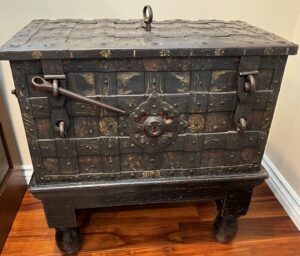 Henri-Louis Duhamel du Monceau (1700-1782), provides some in-depth detail and illustrations in his book “Art du Serrurier Descriptions des arts et métiers” (Art of the Locksmith – Descriptions of Arts and Crafts) published in 1767. Monceau commented: “The locking mechanism consists of moveable and fixed parts. The movement of the key bit guides the centrally placed long bolt that transfers the movement via angled actuators to twelve self-closing obliquely beveled lock bolts, each one under the effect of ring-shaped springs.”2
Henri-Louis Duhamel du Monceau (1700-1782), provides some in-depth detail and illustrations in his book “Art du Serrurier Descriptions des arts et métiers” (Art of the Locksmith – Descriptions of Arts and Crafts) published in 1767. Monceau commented: “The locking mechanism consists of moveable and fixed parts. The movement of the key bit guides the centrally placed long bolt that transfers the movement via angled actuators to twelve self-closing obliquely beveled lock bolts, each one under the effect of ring-shaped springs.”2
Another 18th century illustration can be found in “L’Encyclopédie” or “Dictionaire raisonné des Sciences, des Arts et des Metiers” (The Encyclopedia” or “Reasoned Dictionary of Sciences, Arts and Crafts) written by Denis Diderot (1713-1783).3
Looks Can Be Deceiving
At the front face of most Armada chests, there is a false keyhole plate or escutcheon made of hammered iron flanked by two latches that fit over eyelets attached to the lid. Chests could have a single lock placed on each eyelet or opt for a long iron bar to be inserted through each eyelet and have a single lock attached through a hole at the end of the bar. Some hasps come engraved, which would have been done while the iron was hot and soft, which would make etching and cutting much easier.
Although some chests do not have the pair of hasps with eyelets, most did come with the false keyhole plate. These decorative escutcheons came in a variety of shapes, sizes, and designs. Some were very simple, while others were quite ornate. At first glance, one would assume that the chest was secured by the two outer locks hung on each eyelet and one interior lock between them that is actually fake.
This false lock facade’s only real purpose was to deceive thieves into thinking it was the last hurdle to open the chest. When in reality, the nightmare of trying to open one of these chests would have only just begun, especially without the help of a modern-day cutting torch or electric tools.
To give you an idea of some of the false keyhole escutcheon plate designs, here are four examples:
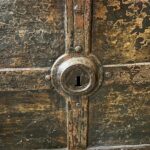 1. A round and very simple plate. 1. A round and very simple plate. |
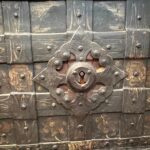 2. A more ornate “rosette” style plate. 2. A more ornate “rosette” style plate. |
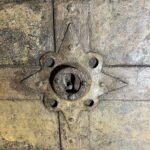 3. A “four-pointed star” shaped plate. 3. A “four-pointed star” shaped plate. |
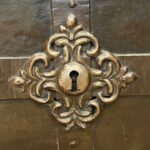 4. A “fancy floret” style plate. 4. A “fancy floret” style plate. |
The Hidden Lock
The main locking mechanism of the Armada chest is typically accessed on the top of the lid by means of a keyhole hidden under a cleverly camouflaged spring-loaded door or false rivet. When the rivet or door is lifted and slid to one side, a keyhole is revealed where the key can be inserted into the lock.
Once the key is inserted into the lock, the locking mechanism requires considerable pressure to open. This often requires the use of a bar or rod inserted into the key bow for leverage to turn the key.
 |
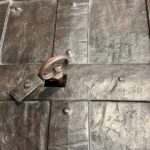 |
 |
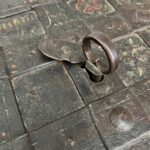 |
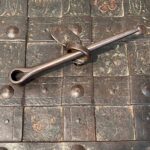 |
General Chest Construction
The outer construction of the chest is made up of a pattern of intersecting iron strips laid over rolled iron sheeting. The strips measure roughly 2-1/4” to 2-1/2” wide and 1/8” thick. These straps are fastened with large iron rivets at each intersection and with smaller rivets spaced about 2” to 4” apart.
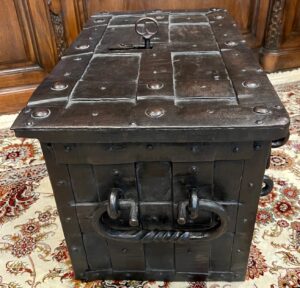 The interior walls are lined with rolled iron sheeting. On the ends, there are heavy twisted iron handles designed to carry heavy weight.
The interior walls are lined with rolled iron sheeting. On the ends, there are heavy twisted iron handles designed to carry heavy weight.
Some of the early chests were made entirely out of solid rolled iron without intersecting strips and riveted on the edges with iron corner cover pieces.
The exterior of the chests were often Dutch polychromed with flowers, and vignettes of boats, hunting and fishing scenes or other designs.
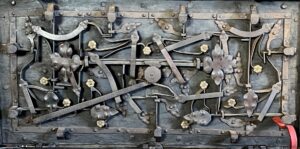 The complex locking mechanism is comprised of numerous leaf springs, levers, bolts, and other components designed to operate in unison when the lock is turned. Some chests have a small inner lock box with a separate key that could have been used to hold jewelry or documents.
The complex locking mechanism is comprised of numerous leaf springs, levers, bolts, and other components designed to operate in unison when the lock is turned. Some chests have a small inner lock box with a separate key that could have been used to hold jewelry or documents.
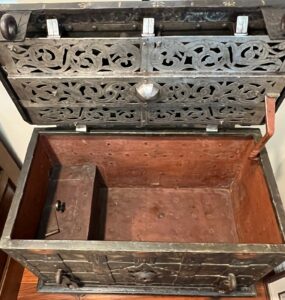 The interior is typically painted a brown or orange color. The application of paint was very important as it helped to prevent corrosion, especially from the salt air these chests were exposed to on voyages across the oceans.
The interior is typically painted a brown or orange color. The application of paint was very important as it helped to prevent corrosion, especially from the salt air these chests were exposed to on voyages across the oceans.
The Artistry of the Engravers
Some of the most desirable Armada chests are those that have beautifully engraved and brightly polished steel cover plates that conceal the locking mechanism.
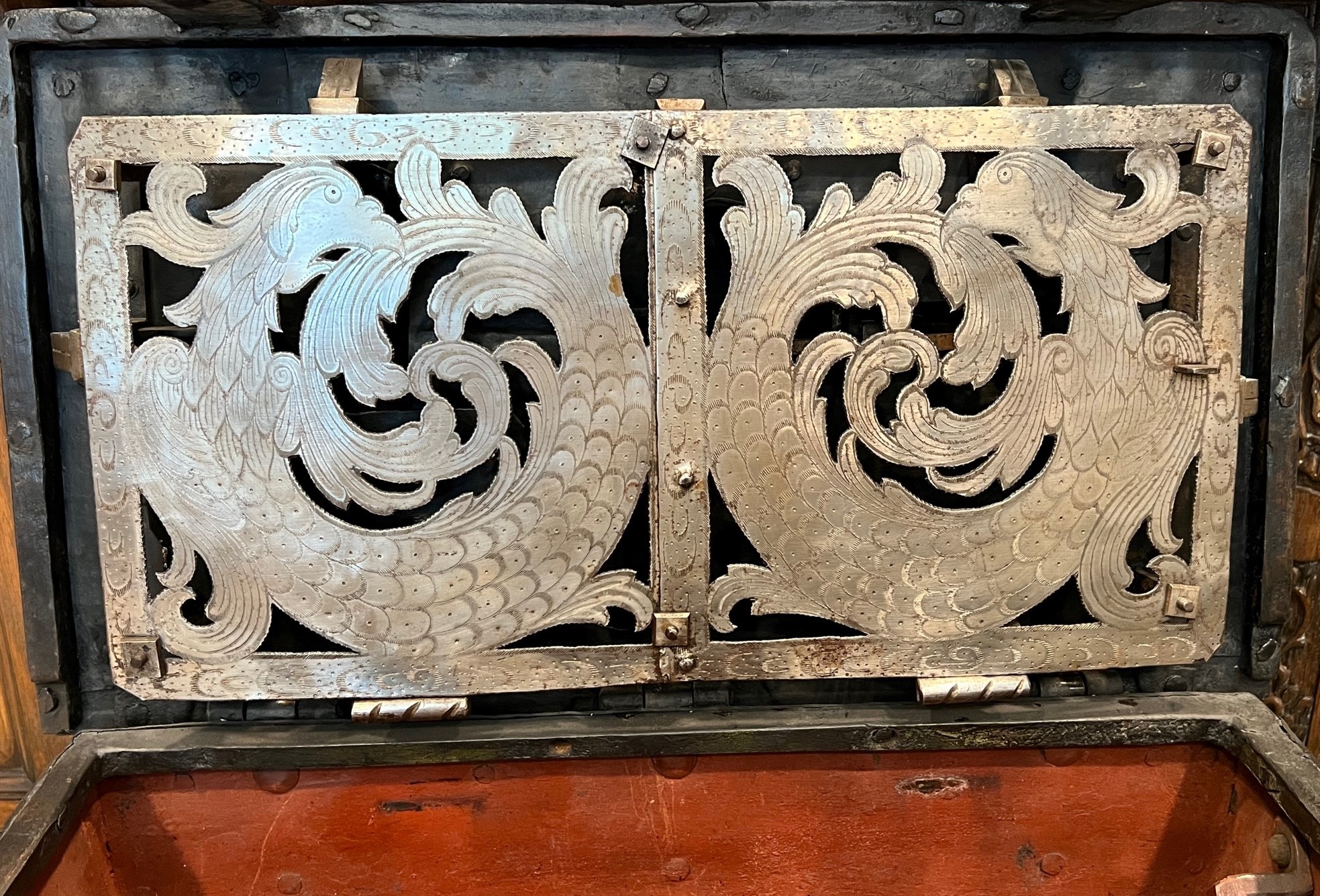 These cover plates often display animals, fish, serpents, dragons or other mythical creatures, royal crests or other designs depending on the wishes of the owner at the time.
These cover plates often display animals, fish, serpents, dragons or other mythical creatures, royal crests or other designs depending on the wishes of the owner at the time.
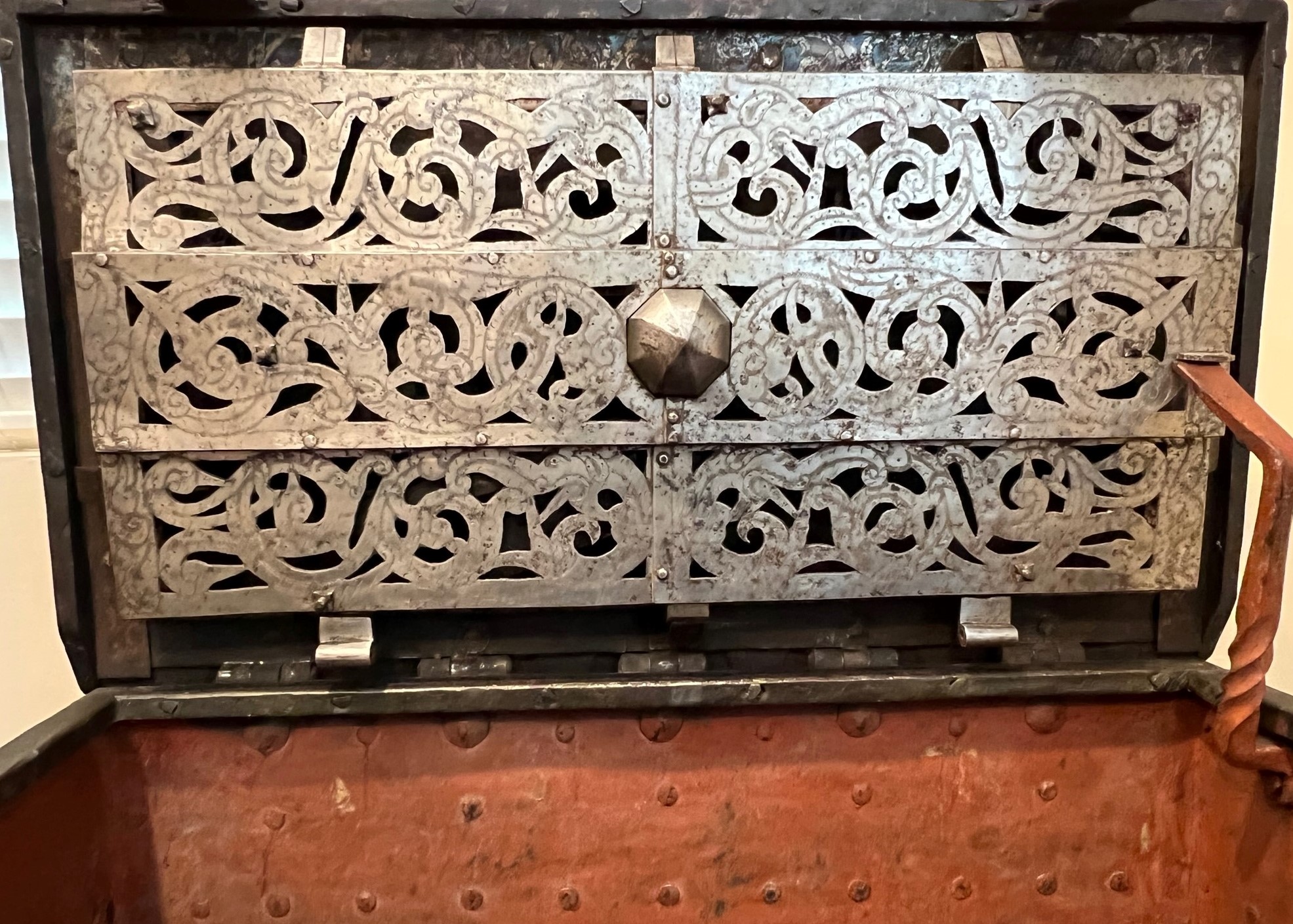 These plates are often well preserved versus the exterior paint, which is rarely preserved or original.
These plates are often well preserved versus the exterior paint, which is rarely preserved or original.
Some chests were commissioned by noblemen or wealthy merchants and have exceptionally detailed engraving, metal bluing, gilding, and painted vignettes.
The Armada Chest Keys
Armada chest keys are typically heavy and made of cast iron or steel. The top or “bow” of the keys are typically round with a pointed dimple located inside the bow at the bottom center known as a “tongue ring”. The “bit” or cut keyed portion at the end of the key is uniquely hand cut for each lock. The “shank” or length of the key from the bottom of the bow to the end of the bit for mid-size chests can range from 2” to 3”.
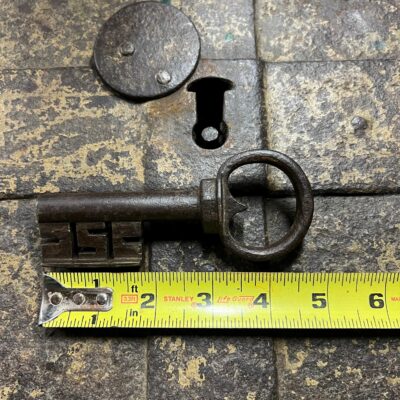 |
 |
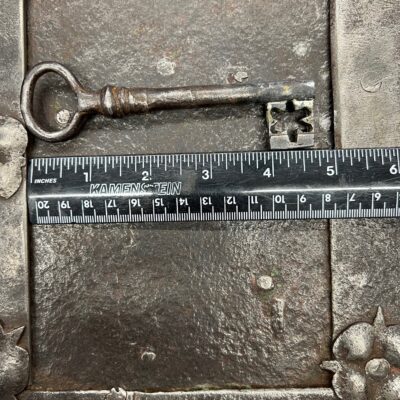 |
Some of the locks that were used on the hasps of Armada chests are illustrated in “Art du Serrurier”, Description des arts et métiers”, 1767 here: https://gallica.bnf.fr/ark:/12148/bpt6k5408471w/f389.item
An Armada Chest Style Jewelry Casket
The craftsmen and blacksmiths who made Armada chests, built them to order. They came in a variety of shapes and sizes, with the rarest being the small jewelry casket. These were often used to hold jewelry during travels and could easily be tucked away inside luggage on a wagon or even in a horses saddlebag. They were also likely used to keep jewelry or gold coins safe in ones home, where they could have been hidden under floor boards or stashed inside the niche’s of a castle walls. This 9″ jewelry casket below is extremely rare and displays a beautiful floral motif on the exterior and the original etched and blued escutcheon plate that covers the locking mechanism. Finding any chest from this period where the bluing has survived in this level of preservation is extremely rare. This casket was probably owned by a wealthy nobleman, merchant or member of a royal family.
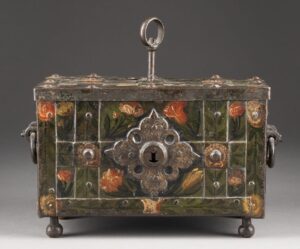
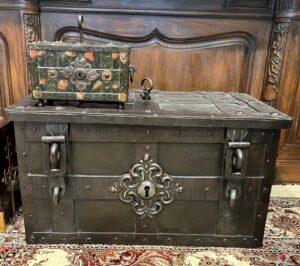
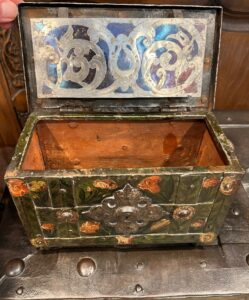
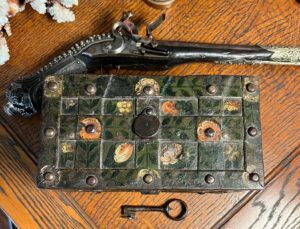
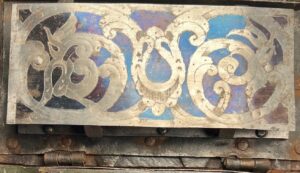
The Décor of Armada Chests
During the 16th-18th centuries, Armada chests were often beautifully decorated and polychrome painted with a variety of motifs. Many chests show indications of Dutch influence as it is common to see chests display windmills and the use of flowers, particularly tulips. Other decorations include trees, sailboats, animals, houses or castles, or other decorative features. Some are adorned with more detailed vignettes of hunting or fishing scenes, portraits or people, the crosses at Calvary, or images depicting important biblical events.




The application of paint had two main purposes, one was for decoration to add beauty to what might normally be a quite unattractive black iron box. The other purpose was to protect the metal from corrosion and rust as many were used to carry valuables on voyages across the oceans where exposure to saltwater or salt air would quickly deteriorate the iron.
It is believed that the person who commissioned a chest to be made, also provided instructions on what the painting of the chest should depict. Sometimes the depictions contain hidden clues as to who may have owned the chest, names, or the date when the chest was made.
These wonderful chests appeal to all sorts of collectors. Some just appreciate the beautiful artwork of the painting and engraving, some are fascinated by the intricate locking mechanism and engineering, while others really enjoy owning a real treasure chest!
References & Sources:
1) George Washington’s Mount Vernon: https://emuseum.mountvernon.org/objects/2557/iron-chest
2) Duhamel du Monceau, “Art du Serrurier”, Description des arts et métiers, printed in Paris 1767) A digital copy is available as well as an illustration of the chest construction at https://gallica.bnf.fr/ark:/12148/bpt6k5408471w/f387.item
3) L’Encyclopédie” or “Dictionaire raisonné des Sciences, des Arts et des Metiers” written by Denis Diderot (1713-1783). https://artflsrv04.uchicago.edu/philologic4.7/encyclopedie0922/navigate/26/9/29
4) The Domain of Chaumont-sur-Loire https://domaine-chaumont.fr/en/chateau-historic-grounds-and-stables/historical-apartments/guard-room
5) Information on the “Blacksmith” https://en.wikipedia.org/wiki/Blacksmith
6) History on medieval blacksmiths https://www.medievalchronicles.com/medieval-people/medieval-tradesmen-and-merchants/medieval-blacksmith/
7) Escutcheon plate details: https://en.wikipedia.org/wiki/Escutcheon_(furniture)
8) Arms & Armor exhibits at the Art Institute of Chicago https://www.artic.edu/collection?classification_ids=arms%20and%20armor&page=5
9) Arms & Armor exhibits at the New York Metropolitan – Wheelock pistol Peter Peck | Double-Barreled Wheellock Pistol Made for Emperor Charles V (reigned 1519–56) | German, Munich | The Metropolitan Museum of Art (metmuseum.org)
10) Photos of wheel lock pistol and suit of armor courtesy of the Metropolitan Museum of Art https://www.metmuseum.org/art/collection/search?showOnly=highlights&department=4
Written by Sean Scott
If you have any questions or comments or have a chest for sale, please feel free to contact Sean Scott at Sean@CommodoreCoins.com.

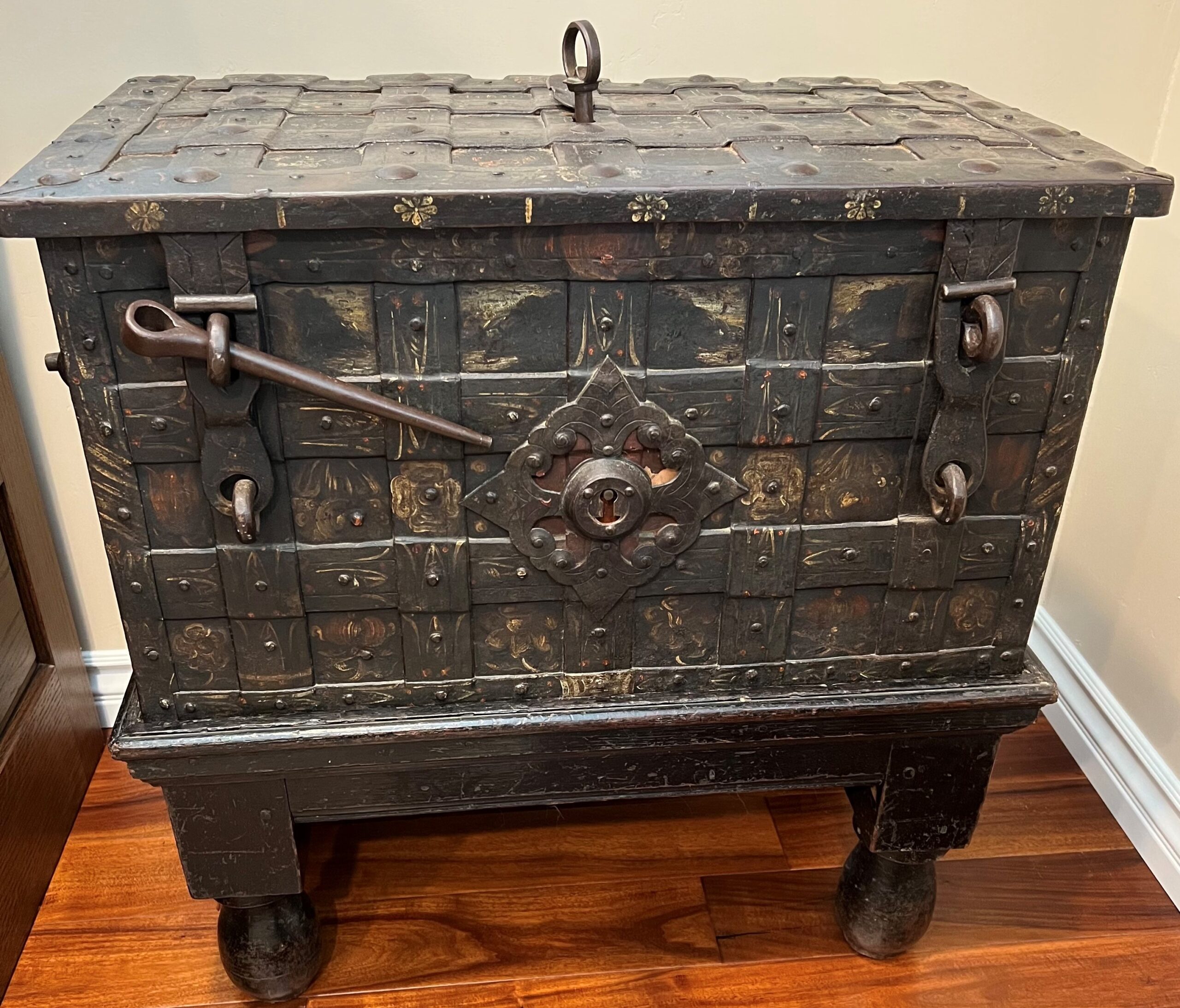
Leave a Reply